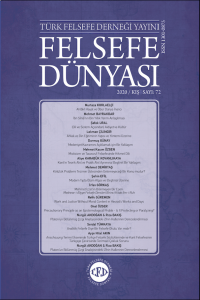Abstract
İhtiyatlılık ilkesi, dünyada sürdürülebilir kalkınmaya yol göstermeyi amaçlayan ilkelerden biridir. Tarihsel olarak, yeni teknolojilerden, ürünlerden, yeniliklerden kaynaklanabilecek önlenebilir zararları engelleme ihtiyacı sonucunda bir ilke olarak gelişmiştir. İhtiyatlılık ilkesi “önleme tedaviden daha iyidir” veya “üzülmektense tedbirli olmak iyidir” cümleleri ile özetlenebilir. İhtiyatlılık ilkesinin hem muhalifleri hem de destekçileri vardır. Muhalifler, bu ilkenin teknolojinin gelişimini yavaşlatacağını veya durduracağını savunmaktadırlar. Bu makalede, ihtiyatlılık ilkesinin yeni teknolojilerin ve yeniliklerin uygulanması konusunda bizi durdurmak yerine bizi olası herhangi bir çevresel zarardan koruduğu iddia edilmektedir. Bu makalede, ihtiyatlılık ilkesi epistemolojik bir sorun olarak ele alınarak, eleştirilere cevap verilerek, ve ayrıca ilkenin tarihsel evriminden, tanımından, uluslararası anlaşmalarda kullanılmasından, ve bir örnek vakadan bahsedilerek tartışılmıştır.
References
- Adams, M. D. (2002). The precautionary principle and the rhetoric behind it. Journal of Risk Research, 5(4), 301–316. doi: 10.1080/13669870210139798.
- Ahteensuu, M. (2007). Defending The Precautionary Principle Against Three Criticisms. TRAMES, 11(61/56), 4, 366–381. Retrieved from http://www.webpages.uidaho.edu/fish510/PDF/Critique%20of%20Precautionary.pdf
- Boodhoo, B. (2006). Book Review: Laws of Fear: Beyond the Precautionary Principle, by Cass R. Sunstein. Osgoode Hall Law Journal, 44(4), 743-752.
- Borne, G. (2011). Precautionary principle. Retrieved from http://www.eoearth.org/view/article/155337
- Carey, G. (1998). Chapter 16: Principles of Evolutionary Psychology. In Human Genetics for the Social Sciences. Retrieved from http://psych.colorado.edu/~carey/hgss/hgsschapters/hgss_chapter16.pdf
- Commission Of The European Communities. (2000). Communication from the commission on the precautionary principle. Retrieved from http://ec.europa.eu/dgs/health_consumer/library/pub/pub07_en.pdf
- European Environment Agency. (2001). Late lessons from early warnings: the precautionary principle 1896–2000, Environmental issue report No 22. Luxembourg: Office for Official Publications of the European Communities.
- Kriebel, D., Tickner, J., Epstein, P., Lemons, J., Levins, R., Loechler, E. L., & ... Stoto, M. (2001). The Precautionary Principle in Environmental Science. Environmental Health Perspectives, (9). 871.
- Origgi, G. (2014). Fear of principles? A cautious defense of the Precautionary Principle. Mind & Society, 13, 215–225. doi: 10.1007/s11299-014-0152-x
- Paralyzing Precautionary Principle. (2014). Problems with The Precautionary Principle. Retrieved from http://paralyzingprecautionprinciple.com/index.html
- Sunstein, C.R. (2003). Beyond the precautionary principle. University of Pennsylvania Law Review, 151(3), 1003-1058.
- Sunstein, C. R. (2005). Laws of Fear: Beyond the Precautionary Principle. Cambridge: Cambridge University Press.
- Tickner, J., & Raffensperger, C. (1998). The Precautionary Principle In Action A Handbook. Retrieved from http://www.sehn.org/precaution.html
- United Nations. (1992). Rio Declaration on Environment and Development. United Nations.
- United Nations Educational, Scientific and Cultural Organization. (2005). The Precautionary Principle. Paris, France: UNESCO.
- World Commission on Environment and Development (WCED). (1987). Our common future. Oxford: Oxford University Press.
- World Health Organization. (2004). The precautionary principle: protecting public health, the environment and the future of our children. Retrieved from http://www.euro.who.int/__data/assets/pdf_file/0003/91173/E83079.pdf
Abstract
The precautionary principle is one of the principles which are intended to lead sustainable development in the world. Historically, it has evolved as a principle because of a need to prevent evitable harms that may arise from new technologies, products, innovations. We can summarize the precautionary principle as “Prevention is better than cure” or “Better safe than sorry.” There are both critics and supporters of the precautionary principle. Critics argue that it will slow down or stop development of technologies. In this paper, I argue that the precautionary principle protects us from any possible environmental harm, instead of paralyzing us regarding the implementation of new technologies and innovations. I discuss the precautionary principle as an epistemological problem, by answering the criticisms, and also by mentioning the historical evolution of the principle, its definition, its uses in the international agreements, and a case study.
References
- Adams, M. D. (2002). The precautionary principle and the rhetoric behind it. Journal of Risk Research, 5(4), 301–316. doi: 10.1080/13669870210139798.
- Ahteensuu, M. (2007). Defending The Precautionary Principle Against Three Criticisms. TRAMES, 11(61/56), 4, 366–381. Retrieved from http://www.webpages.uidaho.edu/fish510/PDF/Critique%20of%20Precautionary.pdf
- Boodhoo, B. (2006). Book Review: Laws of Fear: Beyond the Precautionary Principle, by Cass R. Sunstein. Osgoode Hall Law Journal, 44(4), 743-752.
- Borne, G. (2011). Precautionary principle. Retrieved from http://www.eoearth.org/view/article/155337
- Carey, G. (1998). Chapter 16: Principles of Evolutionary Psychology. In Human Genetics for the Social Sciences. Retrieved from http://psych.colorado.edu/~carey/hgss/hgsschapters/hgss_chapter16.pdf
- Commission Of The European Communities. (2000). Communication from the commission on the precautionary principle. Retrieved from http://ec.europa.eu/dgs/health_consumer/library/pub/pub07_en.pdf
- European Environment Agency. (2001). Late lessons from early warnings: the precautionary principle 1896–2000, Environmental issue report No 22. Luxembourg: Office for Official Publications of the European Communities.
- Kriebel, D., Tickner, J., Epstein, P., Lemons, J., Levins, R., Loechler, E. L., & ... Stoto, M. (2001). The Precautionary Principle in Environmental Science. Environmental Health Perspectives, (9). 871.
- Origgi, G. (2014). Fear of principles? A cautious defense of the Precautionary Principle. Mind & Society, 13, 215–225. doi: 10.1007/s11299-014-0152-x
- Paralyzing Precautionary Principle. (2014). Problems with The Precautionary Principle. Retrieved from http://paralyzingprecautionprinciple.com/index.html
- Sunstein, C.R. (2003). Beyond the precautionary principle. University of Pennsylvania Law Review, 151(3), 1003-1058.
- Sunstein, C. R. (2005). Laws of Fear: Beyond the Precautionary Principle. Cambridge: Cambridge University Press.
- Tickner, J., & Raffensperger, C. (1998). The Precautionary Principle In Action A Handbook. Retrieved from http://www.sehn.org/precaution.html
- United Nations. (1992). Rio Declaration on Environment and Development. United Nations.
- United Nations Educational, Scientific and Cultural Organization. (2005). The Precautionary Principle. Paris, France: UNESCO.
- World Commission on Environment and Development (WCED). (1987). Our common future. Oxford: Oxford University Press.
- World Health Organization. (2004). The precautionary principle: protecting public health, the environment and the future of our children. Retrieved from http://www.euro.who.int/__data/assets/pdf_file/0003/91173/E83079.pdf
Details
| Primary Language | English |
|---|---|
| Subjects | Philosophy |
| Journal Section | Research Articles |
| Authors | |
| Publication Date | December 15, 2020 |
| Submission Date | April 29, 2020 |
| Published in Issue | Year 2020 Issue: 72 |

